fuel SUBARU LEGACY 2006 4.G Owner's Guide
[x] Cancel search | Manufacturer: SUBARU, Model Year: 2006, Model line: LEGACY, Model: SUBARU LEGACY 2006 4.GPages: 425, PDF Size: 6.31 MB
Page 248 of 425
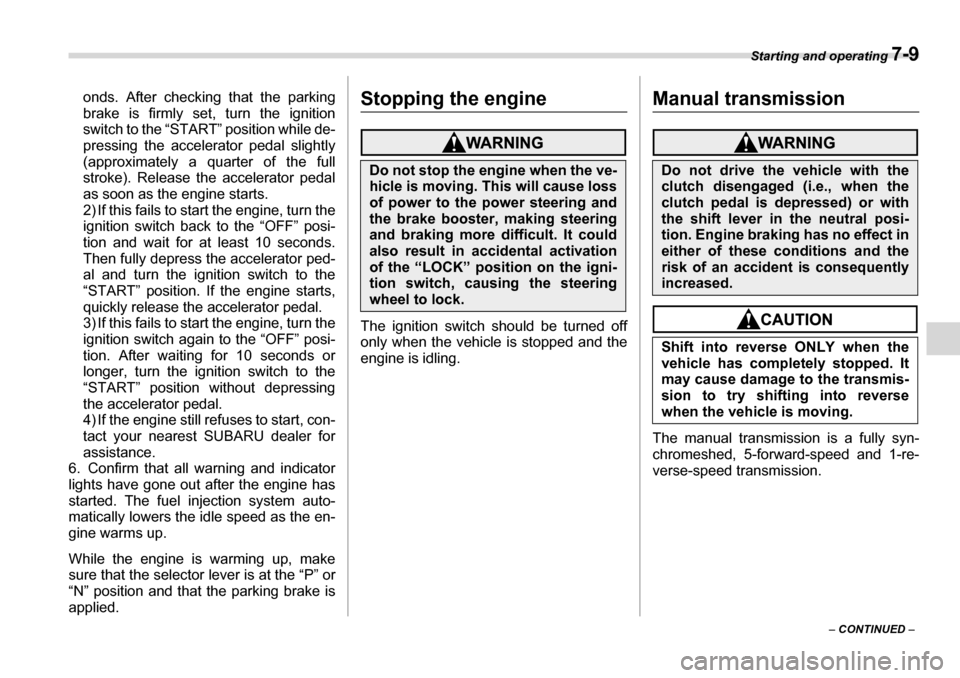
Starting and operating 7-9
– CONTINUED –
onds. After checking that the parking
brake is firmly set, turn the ignition
switch to the “START” position while de-
pressing the accelerator pedal slightly
(approximately a quarter of the full
stroke). Release the accelerator pedal
as soon as the engine starts.
2) If this fails to start the engine, turn the
ignition switch back to the “OFF” posi-
tion and wait for at least 10 seconds.
Then fully depress the accelerator ped-
al and turn the ignition switch to the
“START” position. If the engine starts,
quickly release the accelerator pedal.
3) If this fails to start the engine, turn the
ignition switch again to the “OFF” posi-
tion. After waiting for 10 seconds or
longer, turn the ignition switch to the
“START” position without depressing
the accelerator pedal.
4) If the engine still refuses to start, con-
tact your nearest SUBARU dealer forassistance.
6. Confirm that all warning and indicator
lights have gone out after the engine has
started. The fuel in jection system auto-
matically lowers the idle speed as the en-
gine warms up.
While the engine is warming up, make
sure that the selector lever is at the “P” or
“N” position and that the parking brake is
applied.
Stopping the engine
The ignition switch should be turned off
only when the vehicle is stopped and the
engine is idling.
Manual transmission
The manual transmission is a fully syn-
chromeshed, 5-forward-speed and 1-re-
verse-speed transmission.
Do not stop the engine when the ve-
hicle is moving. This will cause loss
of power to the power steering and
the brake booster, making steering
and braking more difficult. It could
also result in a ccidental activation
of the “LOCK” position on the igni-
tion switch, causing the steering
wheel to lock.Do not drive the vehicle with the
clutch disengaged (i.e., when the
clutch pedal is depressed) or with
the shift lever in the neutral posi-
tion. Engine braking has no effect in
either of these conditions and the
risk of an accident is consequently
increased. Shift into reverse ONLY when the
vehicle has completely stopped. It
may cause damage to the transmis- sion to try shifti ng into reverse
when the vehicle is moving.
Page 249 of 425
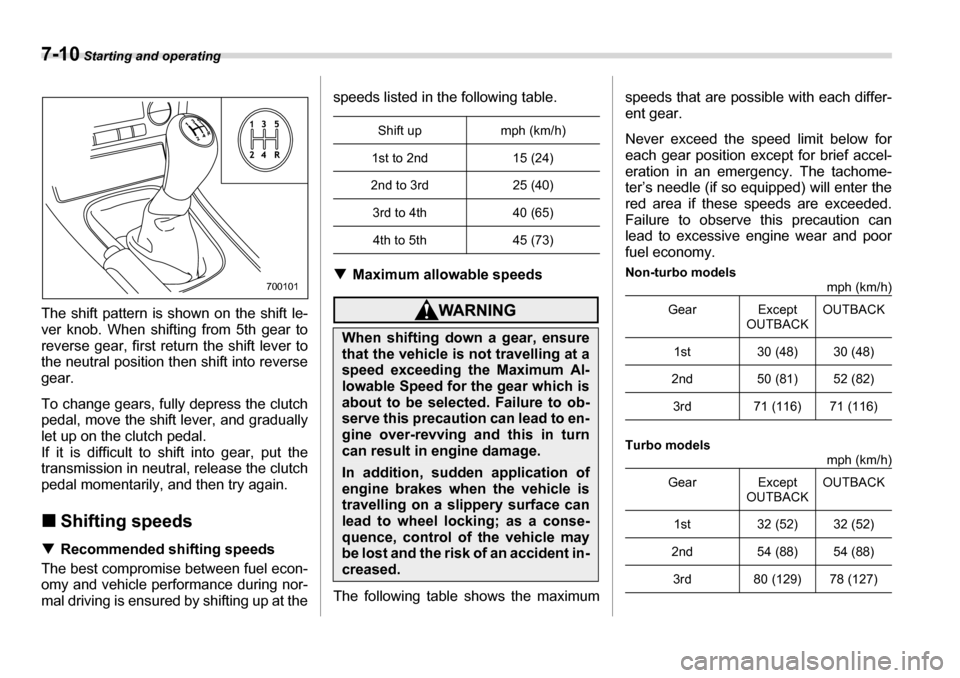
7-10 Starting and operating
The shift pattern is shown on the shift le-
ver knob. When shifting from 5th gear to
reverse gear, first retu rn the shift lever to
the neutral position then shift into reverse
gear.
To change gears, fully depress the clutch
pedal, move the shift lever, and gradually
let up on the clutch pedal.
If it is difficult to shift into gear, put the
transmission in neutral, release the clutch
pedal momentarily, and then try again. �„ Shifting speeds
�T Recommended shifting speeds
The best compromise between fuel econ-
omy and vehicle performance during nor-
mal driving is ensured by shifting up at the speeds listed in the following table. �T
Maximum allowable speeds
The following table shows the maximum speeds that are possible with each differ- ent gear.
Never exceed the speed limit below for
each gear position except for brief accel-
eration in an emergency. The tachome-
ter’s needle (if so equipped) will enter the
red area if these speeds are exceeded.
Failure to observe this precaution can
lead to excessive engine wear and poor
fuel economy.
Non-turbo models
mph (km/h)
Turbo models mph (km/h)
700101
Shift up mph (km/h)
1st to 2nd 15 (24)
2nd to 3rd 25 (40)
3rd to 4th 40 (65)4th to 5th 45 (73)
When shifting down a gear, ensure
that the vehicle is not travelling at a
speed exceeding the Maximum Al-
lowable Speed for the gear which is
about to be selected. Failure to ob-
serve this precaution can lead to en-
gine over-revving and this in turn
can result in engine damage.
In addition, sudden application of
engine brakes when the vehicle is
travelling on a slippery surface can
lead to wheel locking; as a conse-
quence, control of the vehicle may
be lost and the risk of an accident in-
creased.
Gear Except OUTBACKOUTBACK
1st 30 (48) 30 (48)
2nd 50 (81) 52 (82)
3rd 71 (116) 71 (116)
Gear Except OUTBACKOUTBACK
1st 32 (52) 32 (52)
2nd 54 (88) 54 (88) 3rd 80 (129) 78 (127)
Page 254 of 425
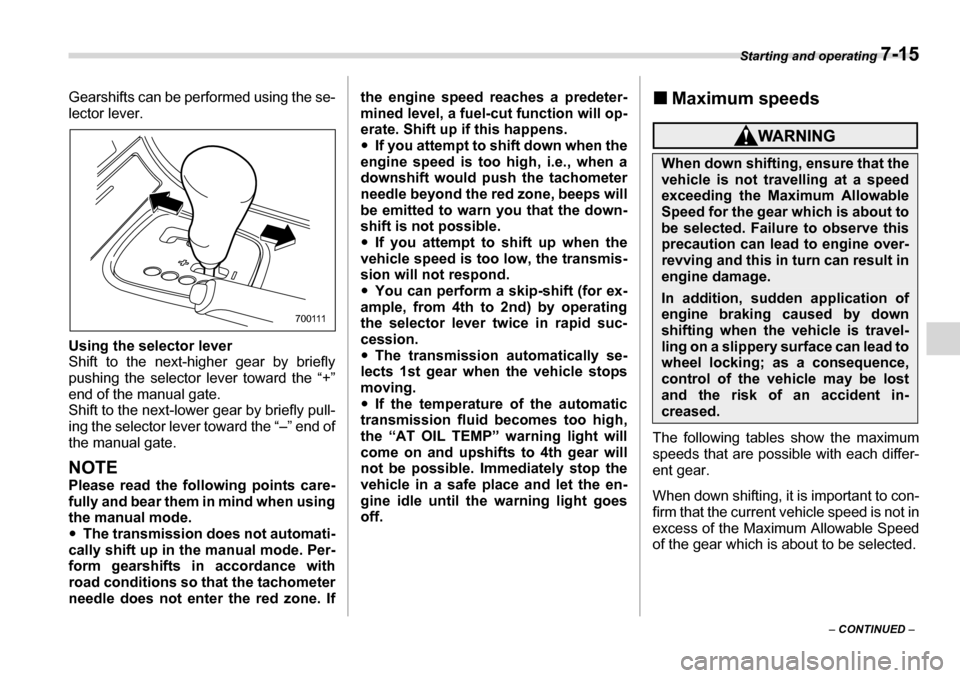
Starting and operating 7-15
– CONTINUED –
Gearshifts can be performed using the se-
lector lever.
Using the selector lever
Shift to the next-higher gear by briefly
pushing the selector
lever toward the “+”
end of the manual gate.
Shift to the next-lower gear by briefly pull-
ing the selector lever toward the “–” end of
the manual gate.
NOTE
Please read the following points care-
fully and bear them in mind when using
the manual mode.�y The transmission does not automati-
cally shift up in the manual mode. Per-
form gearshifts in accordance with
road conditions so that the tachometer
needle does not enter the red zone. If the engine speed reaches a predeter-
mined level, a fuel-cut function will op-
erate. Shift up if this happens.�y
If you attempt to sh ift down when the
engine speed is too high, i.e., when a
downshift would push the tachometer
needle beyond the red zone, beeps will
be emitted to warn you that the down-
shift is not possible. �y If you attempt to shift up when the
vehicle speed is too low, the transmis-
sion will not respond.�y You can perform a skip-shift (for ex-
ample, from 4th to 2nd) by operating
the selector lever twice in rapid suc-
cession. �y The transmission automatically se-
lects 1st gear when the vehicle stops moving. �y If the temperature of the automatic
transmission fluid becomes too high,
the “AT OIL TEMP” warning light will
come on and upshifts to 4th gear will
not be possible. Immediately stop the
vehicle in a safe place and let the en-
gine idle until the warning light goes off. �„
Maximum speeds
The following tables show the maximum
speeds that are possible with each differ-
ent gear.
When down shifting, it is important to con-
firm that the current vehicle speed is not in
excess of the Maximum Allowable Speed
of the gear which is about to be selected.
700111
When down shifting, ensure that the
vehicle is not travelling at a speed
exceeding the Maximum Allowable
Speed for the gear which is about to
be selected. Failure to observe this
precaution can lead to engine over-
revving and this in turn can result in
engine damage.
In addition, sudden application of
engine braking caused by down
shifting when the vehicle is travel-
ling on a slippery surface can lead to
wheel locking; as a consequence,
control of the vehicle may be lost
and the risk of an accident in-
creased.
Page 261 of 425
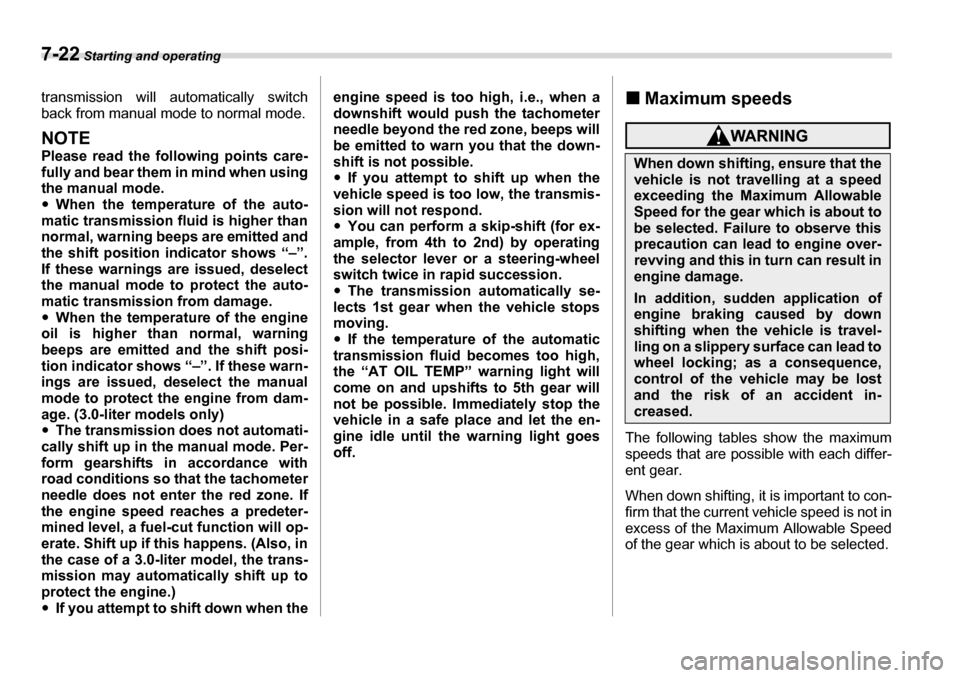
7-22 Starting and operating
transmission will automatically switch
back from manual mode to normal mode.
NOTE
Please read the following points care-
fully and bear them in mind when using the manual mode.�yWhen the temperature of the auto-
matic transmission fluid is higher than
normal, warning beeps are emitted and
the shift position in dicator shows “–”.
If these warnings are issued, deselect
the manual mode to protect the auto-
matic transmission from damage. �y When the temperature of the engine
oil is higher than normal, warning
beeps are emitted and the shift posi-
tion indicator shows “–”. If these warn-
ings are issued, deselect the manual
mode to protect th e engine from dam-
age. (3.0-liter models only)�y The transmission does not automati-
cally shift up in the manual mode. Per-
form gearshifts in accordance with
road conditions so that the tachometer
needle does not enter the red zone. If
the engine speed reaches a predeter-
mined level, a fuel-cut function will op-
erate. Shift up if this happens. (Also, in
the case of a 3.0-liter model, the trans-
mission may automatically shift up to
protect the engine.) �y If you attempt to shift down when the engine speed is too high, i.e., when a
downshift would push the tachometer
needle beyond the red zone, beeps will
be emitted to warn you that the down-
shift is not possible. �y
If you attempt to shift up when the
vehicle speed is too low, the transmis-
sion will not respond. �y You can perform a skip-shift (for ex-
ample, from 4th to 2nd) by operating
the selector lever or a steering-wheel
switch twice in rapid succession.�y The transmission automatically se-
lects 1st gear when the vehicle stops
moving. �y If the temperature of the automatic
transmission fluid becomes too high,
the “AT OIL TEMP” warning light will
come on and upshifts to 5th gear will
not be possible. Immediately stop the
vehicle in a safe place and let the en-
gine idle until the warning light goesoff. �„
Maximum speeds
The following tables show the maximum
speeds that are possible with each differ- ent gear.
When down shifting, it is important to con-
firm that the current vehicle speed is not in
excess of the Maximum Allowable Speed
of the gear which is about to be selected.
When down shifting, ensure that the
vehicle is not travelling at a speed
exceeding the Maximum Allowable
Speed for the gear which is about to
be selected. Failure to observe this
precaution can lead to engine over-
revving and this in turn can result in
engine damage.
In addition, sudden application of
engine braking caused by down
shifting when the vehicle is travel-
ling on a slippery surface can lead to
wheel locking; as a consequence,
control of the vehicle may be lost
and the risk of an accident in-
creased.
Page 280 of 425
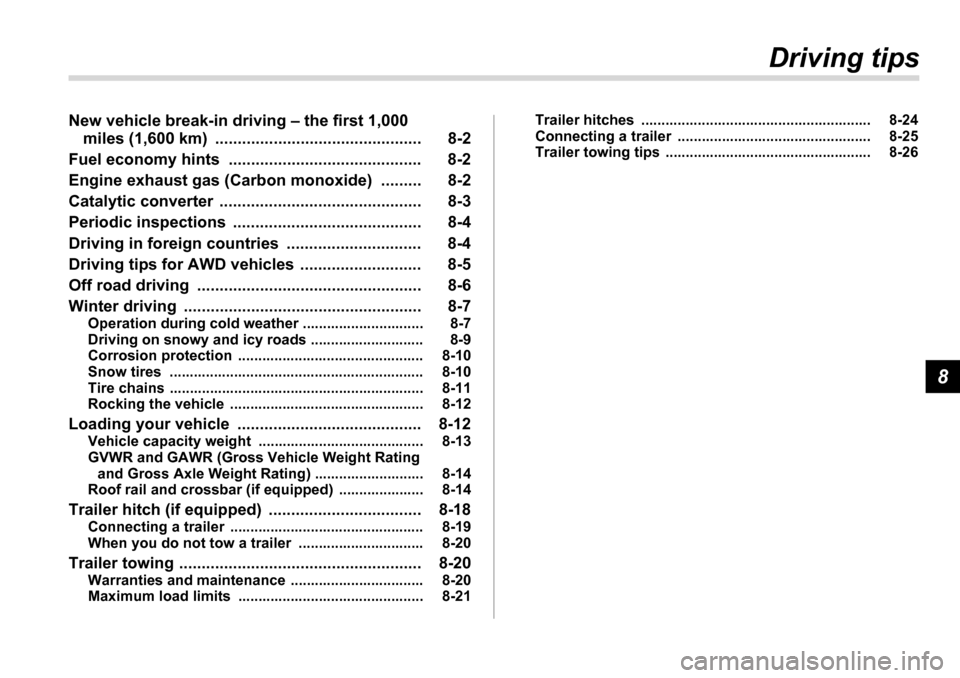
8
Driving tips
New vehicle break-in driving – the first 1,000 miles (1,600 km) ............. ................................. 8-2
Fuel economy hints ............. .............................. 8-2
Engine exhaust gas (Carbon monoxide) ......... 8-2
Catalytic converter ............................................. 8-3
Periodic inspections .......................................... 8-4
Driving in foreign countries .............................. 8-4
Driving tips for AWD vehicles ........................... 8-5
Off road driving .................................................. 8-6
Winter driving ..................................................... 8-7 Operation during cold weather .............................. 8-7
Driving on snowy and icy roads ............................ 8-9
Corrosion protection .............................................. 8-10
Snow tires ............................................................... 8-10
Tire chains ............................................................... 8-11
Rocking the vehicle ................................................ 8-12
Loading your vehicle ......................................... 8-12 Vehicle capacity weight ......................................... 8-13
GVWR and GAWR (Gross Vehicle Weight Rating and Gross Axle Weight Rating) ........................... 8-14
Roof rail and crossbar (if equipped) ..................... 8-14
Trailer hitch (if equipped) .................................. 8-18 Connecting a trailer ................................................ 8-19
When you do not tow a trailer ............................... 8-20
Trailer towing ...................................................... 8-20 Warranties and maintenance ................................. 8-20
Maximum load limits .............................................. 8-21 Trailer hitches ......................................................... 8-24
Connecting a trailer ................................................ 8-25
Trailer towing tips ................................................... 8-26
Page 281 of 425
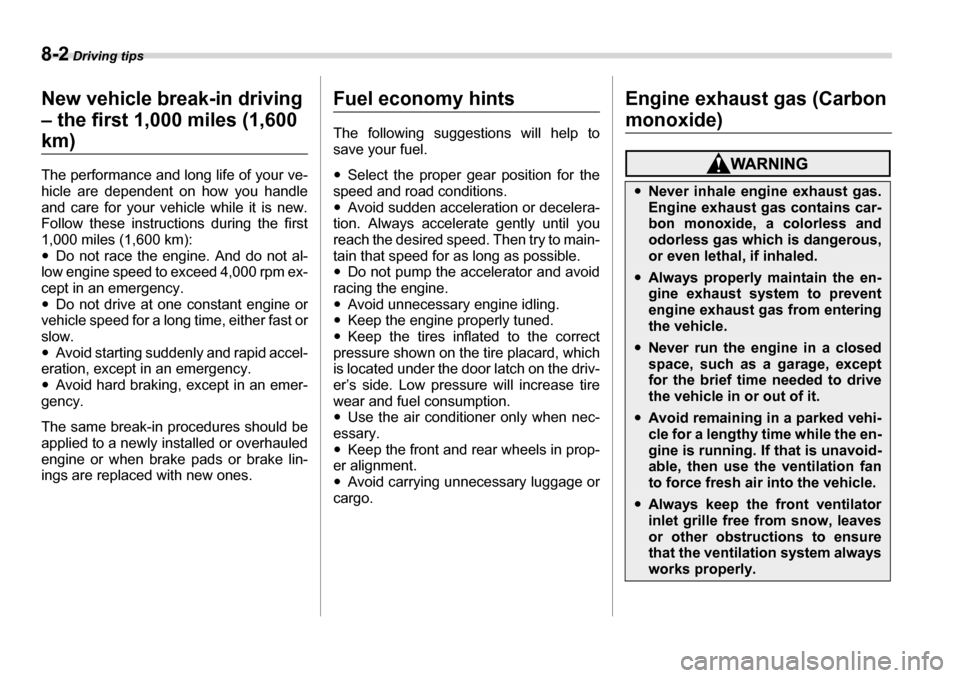
8-2 Driving tips
Driving tipsNew vehicle break-in driving – the first 1,000 miles (1,600
km)
The performance and long life of your ve-
hicle are dependent on how you handle
and care for your vehicle while it is new.
Follow these instructions during the first
1,000 miles (1,600 km):�yDo not race the engine. And do not al-
low engine speed to exceed 4,000 rpm ex-
cept in an emergency.�y Do not drive at one constant engine or
vehicle speed for a long time, either fast orslow.�y Avoid starting suddenly and rapid accel-
eration, except in an emergency.�y Avoid hard braking, except in an emer-
gency.
The same break-in procedures should be
applied to a newly installed or overhauled
engine or when brake pads or brake lin-
ings are replaced with new ones.
Fuel economy hints
The following suggestions will help to save your fuel. �y Select the proper gear position for the
speed and road conditions. �y Avoid sudden acceleration or decelera-
tion. Always accelerate gently until you
reach the desired speed. Then try to main-
tain that speed for as long as possible. �y Do not pump the accelerator and avoid
racing the engine. �y Avoid unnecessary engine idling.
�y Keep the engine properly tuned.
�y Keep the tires inflated to the correct
pressure shown on the tire placard, which
is located under the door latch on the driv-
er’s side. Low pressure will increase tire
wear and fuel consumption. �y Use the air conditioner only when nec-
essary. �y Keep the front and rear wheels in prop-
er alignment.�y Avoid carrying unnecessary luggage or
cargo. Engine exhaust gas (Carbon
monoxide)
�y
Never inhale engine exhaust gas.
Engine exhaust gas contains car-
bon monoxide, a colorless and
odorless gas which is dangerous,
or even lethal, if inhaled.
�yAlways properly maintain the en-
gine exhaust system to prevent
engine exhaust gas from entering
the vehicle.
�yNever run the engine in a closed
space, such as a garage, except
for the brief time needed to drive
the vehicle in or out of it.
�yAvoid remaining in a parked vehi-
cle for a lengthy ti me while the en-
gine is running. If that is unavoid-
able, then use th e ventilation fan
to force fresh air into the vehicle.
�yAlways keep the front ventilator
inlet grille free from snow, leaves
or other obstructions to ensure
that the ventilation system always
works properly.
Page 283 of 425
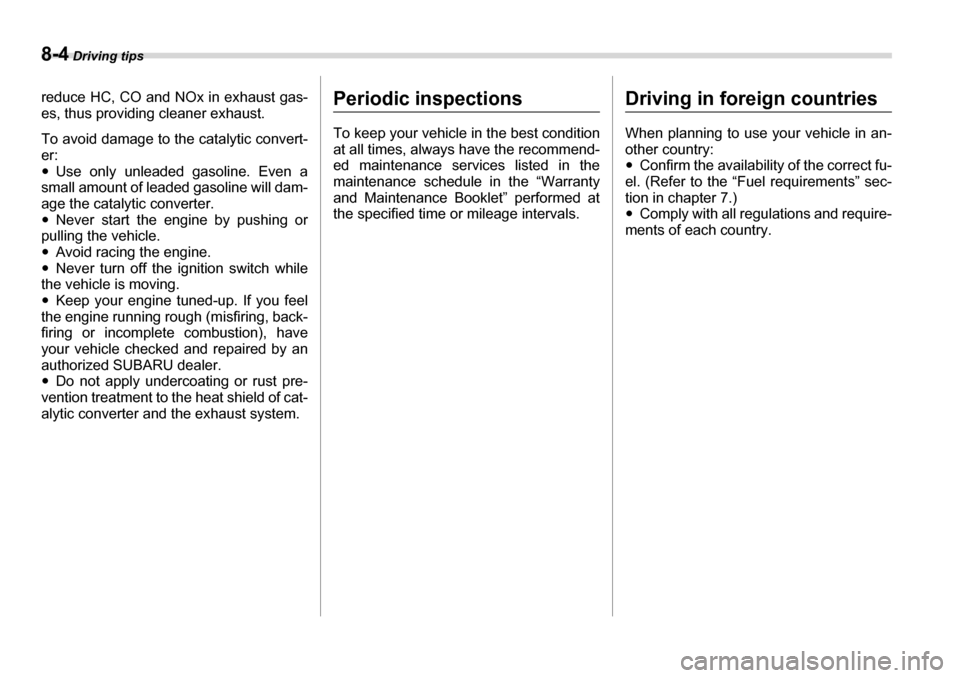
8-4 Driving tips
reduce HC, CO and NOx in exhaust gas-
es, thus providing cleaner exhaust.
To avoid damage to the catalytic convert- er: �yUse only unleaded gasoline. Even a
small amount of leaded gasoline will dam-
age the catalytic converter. �y Never start the engine by pushing or
pulling the vehicle. �y Avoid racing the engine.
�y Never turn off the ignition switch while
the vehicle is moving.�y Keep your engine tuned-up. If you feel
the engine running rough (misfiring, back-
firing or incomplete combustion), have
your vehicle checked and repaired by an
authorized SUBARU dealer. �y Do not apply undercoating or rust pre-
vention treatment to the heat shield of cat-
alytic converter and the exhaust system.Periodic inspections
To keep your vehicle in the best condition
at all times, always have the recommend-
ed maintenance services listed in the
maintenance schedule in the “Warranty
and Maintenance Booklet” performed at
the specified time or mileage intervals.Driving in fo reign countries
When planning to use your vehicle in an- other country: �y Confirm the availability of the correct fu-
el. (Refer to the “Fuel requirements” sec-
tion in chapter 7.) �y Comply with all regulations and require-
ments of each country.
Page 288 of 425
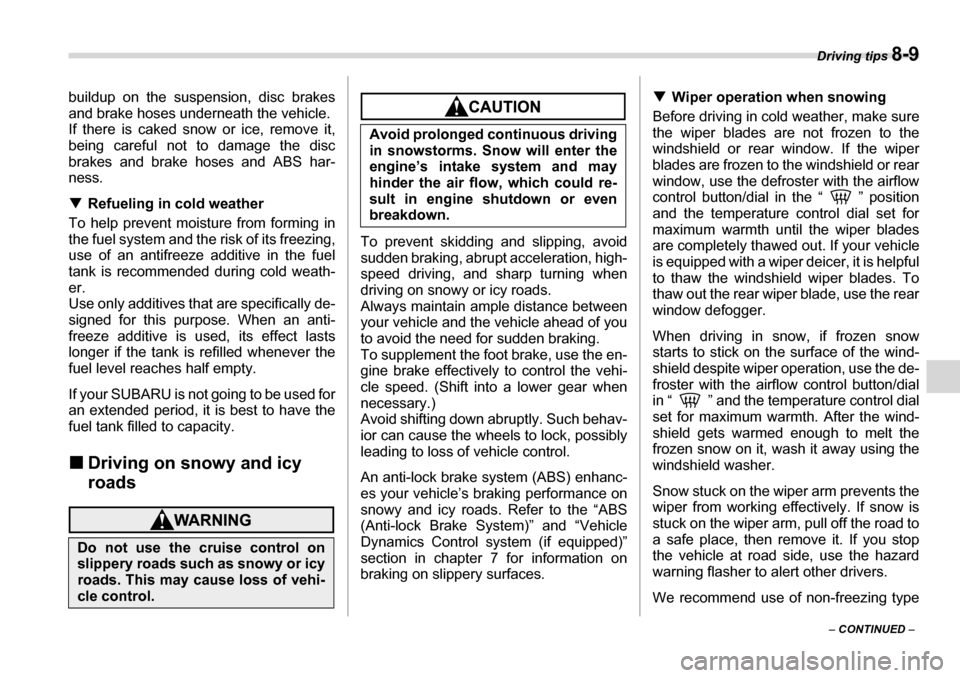
Driving tips 8-9
– CONTINUED –
buildup on the suspension, disc brakes
and brake hoses underneath the vehicle.
If there is caked snow or ice, remove it,
being careful not to damage the disc
brakes and brake hoses and ABS har- ness. �T
Refueling in cold weather
To help prevent moisture from forming in
the fuel system and t he risk of its freezing,
use of an antifreeze additive in the fuel
tank is recommended during cold weath- er.
Use only additives that are specifically de-
signed for this purpose. When an anti-
freeze additive is used, its effect lasts
longer if the tank is refilled whenever the
fuel level reaches half empty.
If your SUBARU is not going to be used for
an extended period, it is best to have the
fuel tank filled to capacity. �„ Driving on snowy and icy
roads
To prevent skidding and slipping, avoid
sudden braking, abrupt acceleration, high-
speed driving, and sharp turning when
driving on snowy or icy roads.
Always maintain ample distance between
your vehicle and the vehicle ahead of you
to avoid the need for sudden braking.
To supplement the foot brake, use the en-
gine brake effectively to control the vehi-
cle speed. (Shift into a lower gear when necessary.)
Avoid shifting down abruptly. Such behav-
ior can cause the wheels to lock, possibly
leading to loss of vehicle control.
An anti-lock brake system (ABS) enhanc-
es your vehicle’s braking performance on
snowy and icy roads. Refer to the “ABS
(Anti-lock Brake System)” and “Vehicle
Dynamics Control system (if equipped)”
section in chapter 7 for information on
braking on slippery surfaces. �T
Wiper operation when snowing
Before driving in cold weather, make sure
the wiper blades are not frozen to the
windshield or rear window. If the wiper
blades are frozen to the windshield or rear
window, use the defroster with the airflow
control button/dial in the “ ” position
and the temperature control dial set for
maximum warmth until the wiper blades
are completely thawed out. If your vehicle
is equipped with a wiper deicer, it is helpful
to thaw the windshield wiper blades. To
thaw out the rear wiper blade, use the rear
window defogger.
When driving in snow, if frozen snow
starts to stick on th e surface of the wind-
shield despite wiper operation, use the de-
froster with the airflow control button/dial
in “ ” and the temperature control dial
set for maximum warmth. After the wind-
shield gets warmed enough to melt the
frozen snow on it, wash it away using the
windshield washer.
Snow stuck on the wiper arm prevents the
wiper from working effe ctively. If snow is
stuck on the wiper arm, pull off the road to
a safe place, then remove it. If you stop
the vehicle at road side, use the hazard
warning flasher to alert other drivers.
We recommend use of non-freezing type
Do not use the cruise control on
slippery roads such as snowy or icy
roads. This may cause loss of vehi-
cle control.
Avoid prolonged continuous driving
in snowstorms. Snow will enter the
engine’s intake system and may
hinder the air flow, which could re-
sult in engine shutdown or even
breakdown.
Page 292 of 425
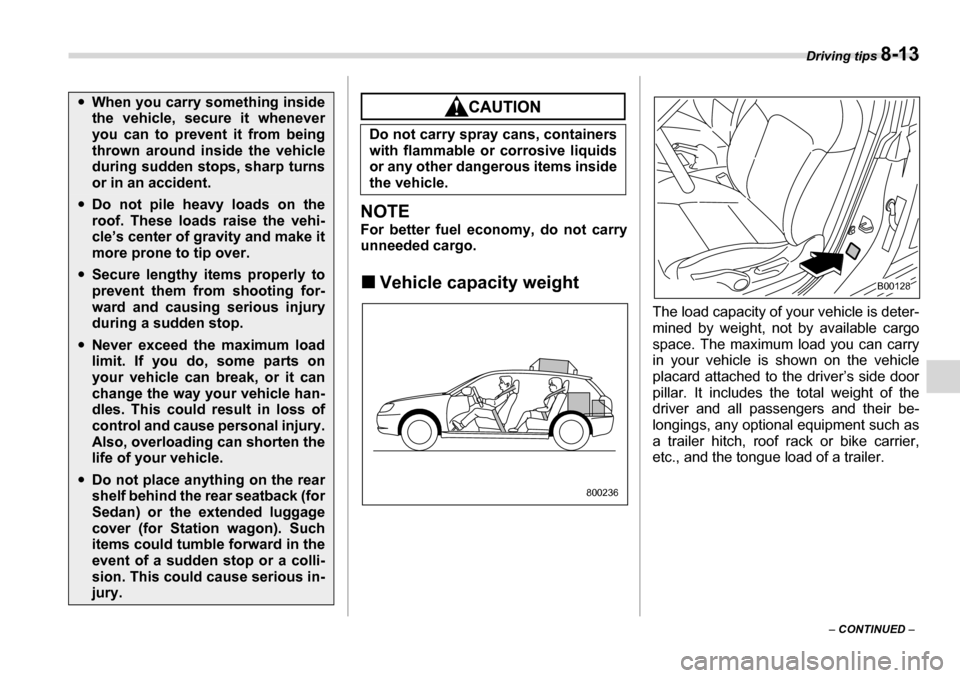
Driving tips 8-13
– CONTINUED –
NOTE
For better fuel economy, do not carry
unneeded cargo. �„Vehicle capacity weight
The load capacity of your vehicle is deter-
mined by weight, not by available cargo
space. The maximum load you can carry
in your vehicle is shown on the vehicle
placard attached to the driver’s side door
pillar. It includes the total weight of the
driver and all passengers and their be-
longings, any optional equipment such as
a trailer hitch, roof rack or bike carrier,
etc., and the tongue load of a trailer.
�yWhen you carry something inside
the vehicle, secure it whenever
you can to prevent it from being
thrown around inside the vehicle
during sudden stops, sharp turns
or in an accident.
�yDo not pile heavy loads on the
roof. These loads raise the vehi-
cle’s center of gravity and make it
more prone to tip over.
�ySecure lengthy items properly to
prevent them from shooting for-
ward and causing serious injury
during a sudden stop.
�yNever exceed the maximum load
limit. If you do, some parts on
your vehicle can break, or it can
change the way your vehicle han-
dles. This could result in loss of
control and cause personal injury.
Also, overloading can shorten the
life of your vehicle.
�yDo not place anything on the rear
shelf behind the rear seatback (for
Sedan) or the extended luggage
cover (for Station wagon). Such
items could tumble forward in the
event of a sudden stop or a colli-
sion. This could cause serious in-
jury.
Do not carry spray cans, containers
with flammable or corrosive liquids
or any other dangerous items inside
the vehicle.
800236
B00128
Page 299 of 425
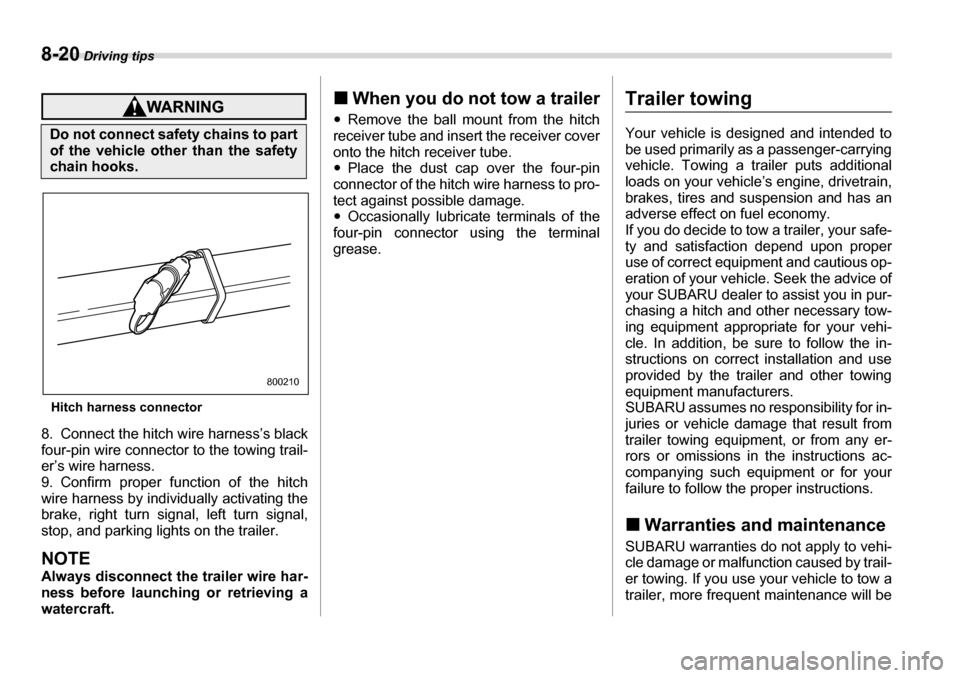
8-20 Driving tips
Hitch harness connector
8. Connect the hitch wire harness’s black
four-pin wire connector to the towing trail-
er’s wire harness.
9. Confirm proper function of the hitch
wire harness by individually activating the
brake, right turn signal, left turn signal,
stop, and parking lights on the trailer.
NOTE
Always disconnect the trailer wire har-
ness before launching or retrieving awatercraft. �„
When you do not tow a trailer
�y Remove the ball mount from the hitch
receiver tube and insert the receiver cover
onto the hitch receiver tube. �y Place the dust cap over the four-pin
connector of the hitch wire harness to pro-
tect against possible damage. �y Occasionally lubricate terminals of the
four-pin connector using the terminal
grease.
Trailer towing
Your vehicle is designed and intended to
be used primarily as a passenger-carrying
vehicle. Towing a trailer puts additional
loads on your vehicle’s engine, drivetrain,
brakes, tires and suspension and has an
adverse effect on fuel economy.
If you do decide to tow a trailer, your safe-
ty and satisfaction depend upon proper
use of correct equipment and cautious op-
eration of your vehicle. Seek the advice of
your SUBARU dealer to assist you in pur-
chasing a hitch and other necessary tow-
ing equipment appropriate for your vehi-
cle. In addition, be sure to follow the in-
structions on correct installation and use
provided by the trailer and other towing
equipment manufacturers.
SUBARU assumes no responsibility for in-
juries or vehicle damage that result from
trailer towing equipment, or from any er-
rors or omissions in the instructions ac-
companying such equipment or for your
failure to follow the proper instructions. �„ Warranties and maintenance
SUBARU warranties do not apply to vehi-
cle damage or malfunction caused by trail-
er towing. If you use your vehicle to tow a
trailer, more frequent maintenance will be
Do not connect safety chains to part
of the vehicle other than the safety
chain hooks.
800210